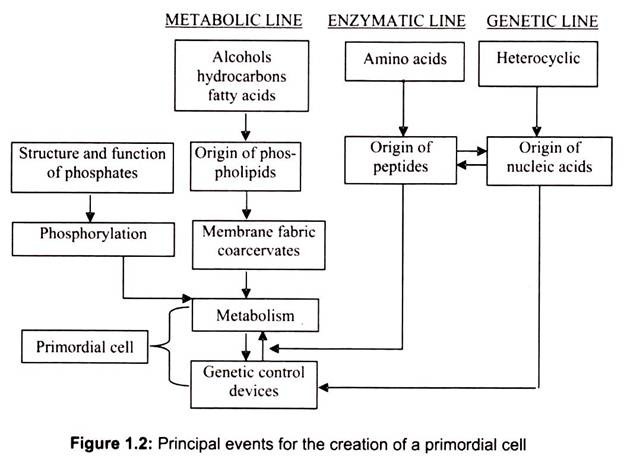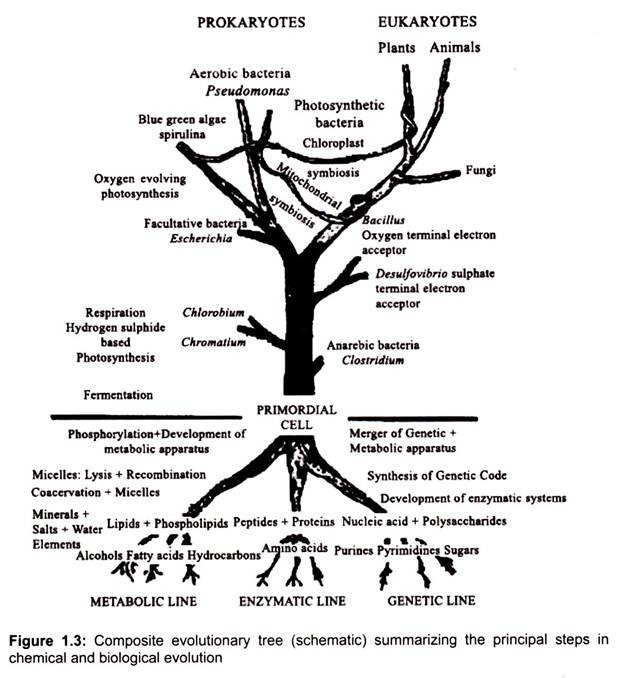After reading this essay you will learn about the evolution of the first living cell.
During the initial degassing stage of the earth, which resulted in the formation of the atmosphere and hydrosphere, prebiotic C-H-N-O-P-S compounds became rapidly discharged along the same channels, where lower-melting material is presently moving upward. As a function of temperature gradients within the rock formation, a series of organic fronts developed with organic compounds.
Since minerals could act as catalysts or as templates in the course of this development, a wide spectrum of new compounds were generated, many of which were eventually released to the hydrosphere and atmosphere. A proto-biosphere was then formed in which minerals, emulsions, and water-soluble compounds coexisted. This type of substrate is considered the starting material for the generation of the first living cell.
Cell is the basic building block of all living organisms. To protect the integrity and maintain the function, the cellular inclusions must be separated from its surroundings. This function is provided by the plasma membrane, which is made up of a double layer of phospholipids. They are only permeable to small, uncharged molecules like H2O, CO2, and O2. Specialized trans membrane transporters are needed for ions, hydrophilic and charged organic molecules (e.g., amino acids and nucleotides) to pass into and out of the cell.
The first beings were probably much like coacervates. As a group, these bacteria are called heterotrophic anaerobes, because there was virtually no oxygen in the atmosphere at that time. The fossils of some these oldest known forms of life have been found in Australian rocks dating back 3.5 billion years (Fig. 1.2).
To create energy, these early bacteria probably consumed naturally occurring amino acids. Amino acids, sugars, and other organic compounds formed spontaneously in the atmosphere then dissolved in liquid water. Upon digesting these molecules, early bacteria produced methane and carbon dioxide as waste products.
Fermenting bacteria would be an example from today of what these early creatures might have been like. Bacteria take the sugars and produce alcohol and carbon dioxide gas as waste products. In the early earth, the alcohol and carbon dioxide became part of the natural environment.
Over a very long time, gradual changes in the earliest cells gave rise to new life forms (Fig. 1.3). These new cells were very different from the earlier heterotrophs because they were able to get their energy from a new source – the sun, the origin of autotrophs, meaning “self-feeders”. The autotrophic bacteria were able to feed themselves by using the energy of the Sun and they were no longer dependent on the same limited food supply as their ancestors were able to flourish. Over millions of years of evolution, photosynthetic bacteria eventually gave rise to modern day plants.
The origin and evolution of man has been the most attractive and complicated problem for the man himself since the time immemorial. Religion had shed impressions such as man had been created by God until the last century when Charles Darwin was able to put forward his theory of evolution of organic world. There are convincing evidences to support the evolutionary origin of human from common ancestors of other anthropoids such as Chimpanzee and Gorilla. The evidences include similarities in morphological, physiological and embryonic features.
The search for the scientific basis of evolution of life is still going on. Many theories are developed and some of them faded due to their draw backs or inability to explain the basic science. One thing is true that the life originated on earth and progressive adaptations and changes in the genotypes and the associated phenotypic changes resulted in the origin of diverse living systems.
Cytology, more commonly known as cell biology, include studies of cell structure, cell composition, and the interaction of cells with other cells and the larger environment in which they exist. Cytology can also refer to cytopathology, which analyzes cell structure to diagnose disease. Microscopic and molecular studies of cells can focus on either multi-celled or single-celled organisms.
Recognizing the similarities and differences of cells is of the utmost importance in cytology. Microscopic examination can help in identify different types of cells. Looking at the molecules which form a cell, sometimes called molecular biology, helps in further description and identification. All fields of biology depend on the understanding of cellular structure. The field of genetics exists because we understand cell structure and components.
Another important aspect in the discipline of cytology is examining cell interaction. By studying how cells are related to other cells or to the environment, cytologists can predict problems or examine environmental dangers to cells, such as toxic or cancer-causing substances. Also cytology deals with the abnormalities in the function of a cell.

